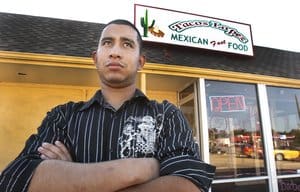“David Hernandez was working at Tacos Lopez, 795 N. West St., when two men burst in just after 2 a.m. One had a pistol,” kansas.com reports. “Hernandez said he was mopping the floor when the gun-toting robber demanded money and grabbed Hernandez’s co-worker, Maria Ibbarra, by the hair and forced the two of them to lay on the floor in a closet at the back of the restaurant.” Question: at what point do you attack a gunman? Krav Maga training says as soon as possible (i.e. immediately) with as much violence as possible. That’s what I teach my girls in terms of kidnapping; better to die on the street than allow a perp to remove you from the scene . . .
But for most people in most gun-involved situations, the answer depends on a range of variables: their skill level, available weapons, potential cover or concealment, whether or not they have children with them, etc.
I reckon the gunman or woman’s demeanor and behavior are two of the most important factors you must consider, should you find yourself in Hernandez’ shoes.
In this case, a robber grabbed his co-worker by the hair. That’s a red flag that the perps are prone to violence. The moment Ms Ibbara was physically assaulted Hernandez needed to increase his “I gotta do something” planning process.
Street violence is not necessarily a continuum of escalating physical attacks; the Israeli secret service aren’t the only ones who know the advantages of an overwhelming, unexpected explosion of violence. But criminal violence tends to escalate, especially towards non-aggressive victims. You’re not fighting back? Good! Then here’s some more!
Sick. But there it is. More worryingly, if shooting is somewhere in a perp’s plans, however haphazard those plans may be, they may need to “warm up” to it. Physical violence and verbal stress are clues that things may be moving from bad to far, far worse.
When the robbers forced Hernandez and Ibbara into a back room, Hernandez was 100 percent correct to counter-attack. He had a reasonable expectation that he was about to be executed. The only considerations: where, when and how?
[Note: if you were in this scenario, hidden with your self-defense weapon drawn, the action of moving the employees to the back would have provided justification for shooting. Mind you, you are under no obligation to play Dirty Harry.]
The fear in Ibbarra’s eyes and a nearby wrench, Hernandez said, motivated him to action.
He threw the wrench at the robber at close range, he said, but missed.
It was enough of a distraction, however, that Hernandez leaped up and grabbed the man’s hands in a fight for the pistol.
“I don’t know where it came from,” Hernandez said in Spanish. “But I was afraid. I thought, ‘If I don’t kill him, he’ll kill me.’ ”
Hernandez wrestled for the gun.
At one point, Hernandez said the robber could have shot him in the stomach. But he didn’t.
Hernandez said he pulled the gun away and punched the robber’s head several times with pistol in hand.
The other suspect tried to fight with Hernandez, too, biting his hand to pry the gun away. But Hernandez said he overpowered him.
“There was blood all over,” Hernandez said.
We don’t know Hernandez’s background. Suffice it to say, it sounds like the restaurant worker knew one end of a gun from another. As this example illustrates, it pays to understand how guns work. And how to stop them from working (hint: push the muzzle away). Gun control advocates too.
Anyway, the real question here is this: what if it had been you? What would you have done if you were Hernandez, Ibbara or a customer, with or without a concealed carry weapon?




